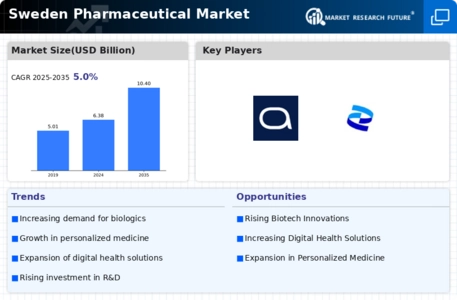Market Growth Projections
The Global Sweden Pharmaceutical Market Industry is poised for substantial growth, with projections indicating an increase from 6.38 USD Billion in 2024 to 10.4 USD Billion by 2035. This growth trajectory suggests a compound annual growth rate (CAGR) of 4.56% from 2025 to 2035. Such figures reflect the industry's resilience and adaptability in the face of evolving healthcare demands. The market's expansion is likely to be driven by a combination of factors, including demographic changes, technological advancements, and an increasing focus on innovative therapies. This growth presents opportunities for stakeholders to invest in new products and services that align with market needs.
Aging Population and Chronic Diseases
The demographic shift towards an aging population in Sweden is a significant driver of the Global Sweden Pharmaceutical Market Industry. As the population ages, there is an increasing prevalence of chronic diseases such as diabetes, cardiovascular disorders, and cancer. This demographic trend necessitates a robust pharmaceutical response to manage these conditions effectively. The market is expected to grow to 10.4 USD Billion by 2035, indicating a strong demand for medications that cater to the needs of older adults. Pharmaceutical companies are likely to focus on developing age-specific formulations and treatments to address this growing patient demographic.
Rising Demand for Innovative Therapies
The Global Sweden Pharmaceutical Market Industry is experiencing a notable increase in demand for innovative therapies, driven by advancements in biotechnology and personalized medicine. As healthcare providers and patients seek more effective treatment options, the industry is adapting to these needs. In 2024, the market is projected to reach 6.38 USD Billion, reflecting a growing investment in research and development. This trend is likely to continue as the industry focuses on developing targeted therapies that address specific patient populations, potentially leading to improved health outcomes and patient satisfaction.
Increased Focus on Preventive Healthcare
There is a growing emphasis on preventive healthcare within the Global Sweden Pharmaceutical Market Industry, as stakeholders recognize the importance of early intervention in managing health outcomes. This shift is reflected in the rising demand for vaccines and preventive medications, which are seen as essential components of public health strategies. The market's expansion to 10.4 USD Billion by 2035 suggests that preventive measures will play a pivotal role in shaping future pharmaceutical offerings. Companies may increasingly invest in research to develop innovative preventive therapies, thereby aligning with the global trend towards proactive health management.
Government Support and Regulatory Framework
The Global Sweden Pharmaceutical Market Industry benefits from a supportive government framework that encourages pharmaceutical innovation and investment. The Swedish government has implemented policies aimed at fostering research and development, including tax incentives and funding for biotech startups. This supportive environment is crucial for the growth of the industry, as it enables companies to invest in new drug development and clinical trials. The regulatory landscape in Sweden is also conducive to bringing new therapies to market efficiently, which may enhance the overall competitiveness of the pharmaceutical sector on a global scale.
Technological Advancements in Drug Development
Technological advancements are transforming the Global Sweden Pharmaceutical Market Industry, particularly in drug development processes. Innovations such as artificial intelligence, machine learning, and big data analytics are streamlining research and enhancing the efficiency of clinical trials. These technologies enable pharmaceutical companies to identify potential drug candidates more rapidly and reduce time-to-market for new therapies. As the market is projected to grow at a CAGR of 4.56% from 2025 to 2035, the integration of these technologies is likely to play a crucial role in sustaining this growth trajectory, allowing for more effective and timely responses to emerging health challenges.













Leave a Comment